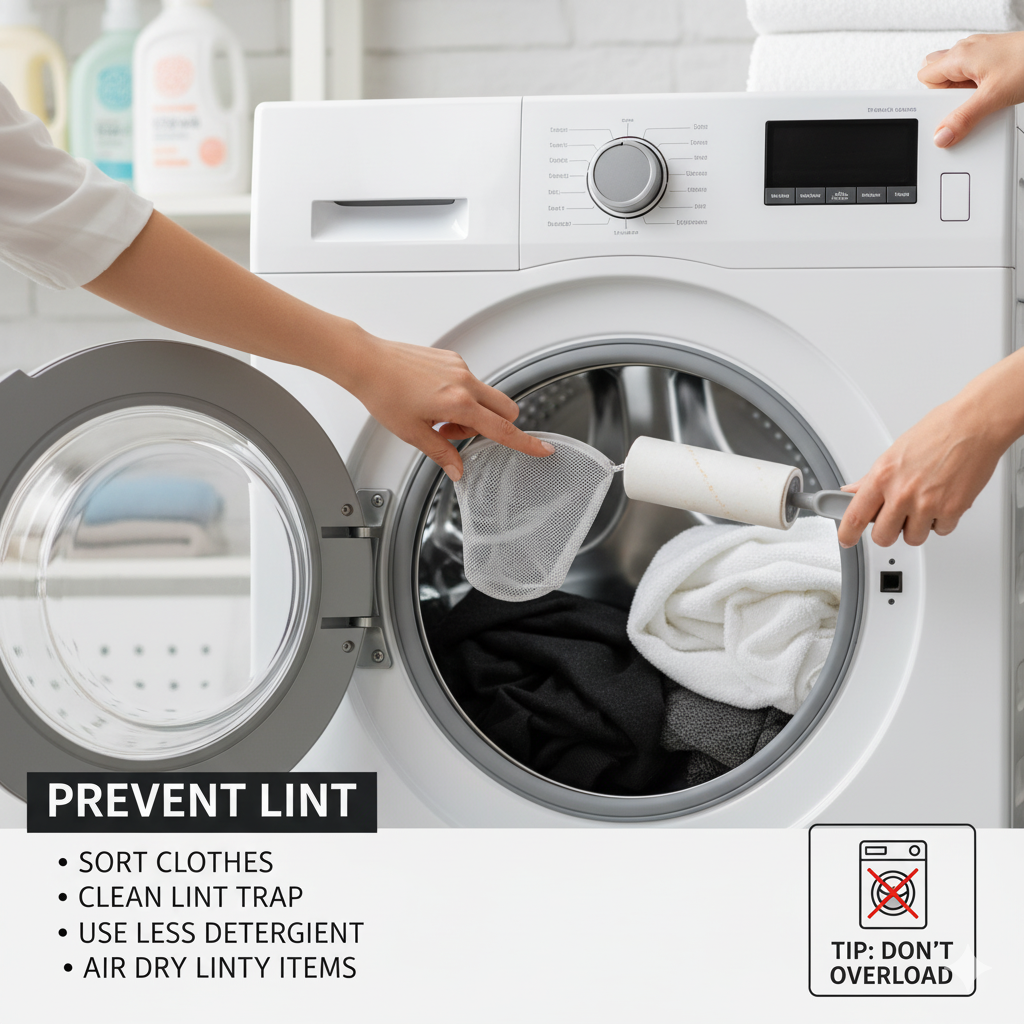Learn how to prevent lint in washing machine with simple tips. Keep your clothes fresh, protect your washer, and enjoy lint-free laundry every time
introduction
If you’ve ever taken your clothes out of the washer only to have them covered in lint, you know how frustrating it can be. Cotton balls are so small that they can adhere to clothing, causing it to appear tired and unkempt. The best part is that lint is something you can actually do something about. Just a few basic habits can help you make your clothes look clean and good, even after every wash. In this post, we’re going to discuss how to prevent lint in the washing machine – why lint occurs, and what you can do about it
How Does Lint Get Into the Washing Machine?

Lint is created when small fibers are loose from clothes in the washing process. These stray fibers attach themselves to other fabrics, especially darker ones, and are challenging to remove. There are a few reasons lint can develop:
Overloading the washing machine: When there is no space for water to move, the fibers rub together, creating more lint.
Not separating fabrics: Mixing a load of towels, sweaters, and dark shirts will result in everything being covered in lint.
Dirty washer filter: Tumbling your lint into a clogged-up filter is just going to put more of it back on your clothes. Old fabrics: Older clothing tends to produce more lint during washing.
Why Preventing Lint Matters
It’s not just about looks. Lint can and will if you don’t:
. Block your washing machine filter.
. Reduce washing performance.
. Clothes wear out faster.
. Even causes drainage problems.
Therefore, practical knowledge on how to prevent lint in a washing machine isn’t just about clean clothes, but also about proper maintenance of your machine.
Sort Your Laundry the Smart Way
One of the best things you can do is separate your clothes before washing them. Wash lint-shedding materials, such as towels, fleece, or sweaters, separately from lint-catching items like dark T-shirts, pants, or leggings.
Consider this: heavy shedding fabrics should be avoided in favor of smooth, dark fabrics. This single action can halve lint issues. Don’t Overload the Washer
It can be tempting to rush through tasks by cramming everything into one big load and getting it over with. But overloading makes lint worse. This space for clothes to move in water would be welcome. If dense, fibers rub against one another more, leading to greater shedding. Never fill the drum to the top.
A good rule of thumb: fill the washer three-fourths of the way, not all the way up.
Clean the Lint Filter Regularly
Your washing machine has a lint filter or trap designed to catch fibers. It doesn’t go away if you don’t clean it, and that collected lint circulates into your clothes.
Inspect the filter periodically, every few washes.
Remove any lint you see. If it appears clogged, rinse under cool running water and allow to dry before replacing.
This tiny habit can save you a lot of lint.
Choose the Right Detergent
Some detergents are too aggressive and can lead to more fiber breakage. A mild liquid detergent is superior because it dissolves nicely and doesn’t leave a residue that can trap lint.
Also, steer clear of overusing detergent. Excess soap equals more suds, which can cause fibers to relax and stick together on clothing.
Wash Clothes Inside Out
When you wash your clothes, always turn them inside out first — doing so helps protect the outer fabric. The friction occurs on the inside layer, so the visible side remains cleaner and less linty. This little trick is particularly effective for dark-colored clothes, such as jeans and cotton t-shirts.
Use Shorter, Gentle Cycles
High-velocity, long wash cycles may damage fibers and form lint. For fabrics that release easily, do a gentle or quick cycle in cold water—that way, there’s less friction to keep your fibers together.
Vinegar in the Rinse Cycle
White vinegar is a natural softener. Adding half a cup of vinegar to the rinse cycle helps relax fibers, allowing them to resist lint and static. Never fear: Your clothes won’t smell like vinegar once they dry.
Air Dry When Possible
Dryers can exacerbate lint, especially for cotton fabrics. If you have the room, hang clothes to dry. Here is a tidy tip: If you need to use a dryer, make sure to clean the lint trap before every load. A clean trap provides fibers with a place to get caught, rather than fly back onto clothes.
The Dos and Don’ts of Lint-Free Laundry
Do’s
. Separate between lint-producing and lint-attracting materials.
. Do clean the dishwasher’s lint filter frequently.
. Do wash clothes inside out.
. Do use gentle cycles and a mild detergent.
. Leave room for clothes to move in the drum.
Don’ts
. Don’t overload the washing machine.
. Do not forget the filter or dryer lint trap.
. Heavy shedding fabrics should not be washed with delicate dark ones. Don’t use too much detergent.
. The machine itself shouldn’t be skipped.
Keep Your Washing Machine Clean

Lint can also be caused by a machine that is not clean. Perform a monthly cleaning cycle using hot water and either vinegar or baking soda. This can help remove any lint, soap, or dirt that’s stuck in the drum or hoses.
A Helpful Tip
And if you have pets, their hair frequently combines with lint, compounding the problem. Remove as much pet hair as you can before washing with a lint roller or brush. This little trick will help reduce lint in your washing machine and keep your clothes looking new for longer.
Conclusion
As small as it is, lint can be the bane of your laundry life if you don’t handle it. You can be a diligent owner and ensure that you’re washing laundry effectively by sorting through clothes, cleaning out the filter, avoiding overpacking, and using more gentle wash settings. A clean washing machine smells fresh and helps keep clothes looking newer, longer. No one enjoys doing laundry in a family of four with two teenagers.
Simple as that, these are the steps on how to avoid lint in a washing machine. Get used to these simple routines, and you’ll see the payoff quickly. With a bit of special care, your clothes look great, and so does your washing machine. Keep going, you’ve got this!
Frequently Asked Questions On How To Stop Lint In a Washing Machine
1. Why do my dark clothes get so much lint on them after I wash them?
Black shows lint more because the tiny fibers stand out against black fabric. To mitigate this, wash them inside out, avoid mixing with lint-producing clothes (such as towels), and keep your washer’s filter clean.
2. How frequently must I clean my washing machine’s lint filter?
You’ll want to inspect the lint filter periodically, every few times you do laundry. So if you see build-up, catch it immediately. Not only does a clogged filter result in wet lint, but it can also impact the performance of your washer.
3. Can I put fabric softener in my dryer to stop lint?
Yes, using liquid fabric softener or even white vinegar in the rinse cycle can help loosen fibers and minimize lint. However, please use it sparingly, as excessive use can also trap fibers as residue.
4. Is overloading the washing machine really what makes lint worse?
Yes. When clothes are not provided enough space to move, they rub against each other more, which creates extra lint. Leave a little bit of room in the drum for water and motion at all times.
Lastly giving you a super cool hack.. watch the video below




